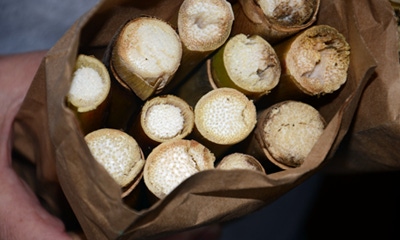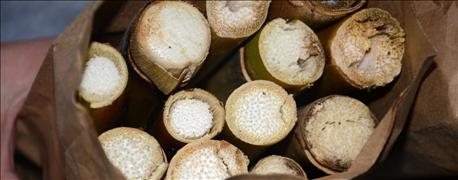
If you’re not in the INfield Advantage on-farm testing program, perhaps you’ve heard of it. It consists of groups of farmers all over Indiana conducting on-farm tests on a particular topic, often nitrogen use in corn, and then comparing results after the season. INfield Advantage is coordinated by the Indiana State Department of Agriculture. If you’re involved, you know that stalk nitrate sampling just before harvest is a key part of the educational program.

BAG OF STALKS: What you can learn from a bag of 8-inch sections of cornstalks may surprise you. Lab results on nitrogen levels may help explain yield differences in the field, or help you plan for next year.
This month’s panel of Indiana Certified Crop Advisers explains what you can learn from stalk nitrate testing. The panel includes Betsy Bower, agronomist, Ceres Solutions, Terre Haute; Dan Ritter, agronomist, Brodbeck Seeds, Rensselaer; and Brian Shrader, accounts manager, DuPont Pioneer, Marion.
One goal of the stalk nitrate testing component in INfield Advantage is to determine if your nitrogen program for corn was sufficient, deficient or excessive that year, Bower says. “The stalk nitrate test allows us to check the remaining nitrate concentration in a stalk after black layer,” she explains. “If the nitrate level is too low, you may be leaving yield on the table.” In other words, if more nitrogen had been available, perhaps the plants would have turned it into a higher yield.
“If the stalk nitrate test is too high, you may be overapplying nitrogen,” she continues. But Bower also notes that stalk nitrate levels vary from year to year. It’s not an exact science. Environmental conditions after N application, such as too dry, too wet or ideal, and the ability of the corn plant to find N in the soil when it needs it are big factors.
“To truly get a feel for whether your nitrogen program is sufficient, you need stalk nitrate test results for at least three to four years, since there are different environmental conditions,” Bower says.
Weather matters
“The biggest lesson [from stalk sampling] is how your present nitrogen fertility program for corn responded to the conditions this year,” Ritter says, agreeing with Bower. “I hesitate making any big changes in N management based on one year.
“Nitrogen and its availability is so dependent on weather. If each year you find you have ample nitrate in stalks, then you may adjust rates down. Or if there seem to be deficiencies [in stalks] on a regular basis, then adjust up," Ritter says.
Shrader adds an important point. “This test only provides a guide on the level of N fertilization and can’t predict either N rates or correlate to yields,” he says. “It serves as a guide, or check, to evaluate your current N program.
"The power comes from continued testing over multiple years and growing environments.”
This year
So what might stalk nitrate tests show this year? It was a warm, wet summer in many parts of Indiana. Agronomists believe results could go one of two ways.
“In a warm and wet season, more nitrogen could have leached out of the root zone and made less available for the plant,” Ritter says.
Bower adds a different spin. “Depending on corn stage, soil type, amount of rain and saturated conditions, we may find low stalk nitrate levels, indicating we might have left some yield on the table,” she says.
“Where conditions were ideal we would expect ideal stalk nitrate levels, indicating we didn’t under- or overapply N. In years with high yields and very good grain fill, it’s not uncommon to find high stalk nitrate levels.”
About the Author(s)
You May Also Like




